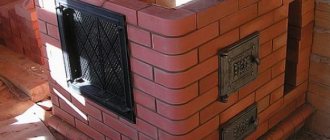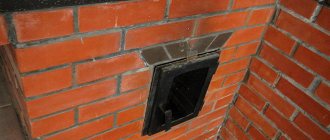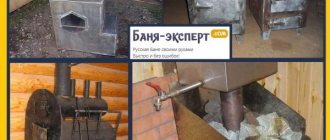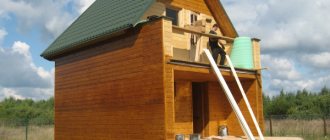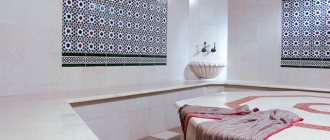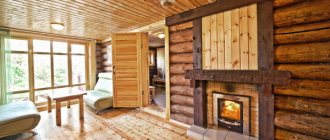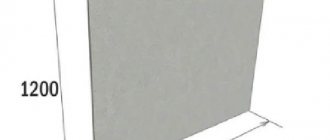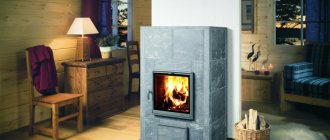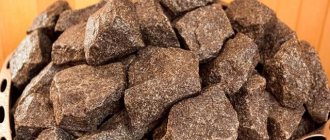Necessity of finishing
The finishing of the stove in the bathhouse (a photo of a successful job is presented below) can be made of different materials. After the brickwork is created, it needs to be given a spectacular appearance. When choosing materials, it is worth considering that they should not inhibit the spread of heat from the stove. Therefore, certain requirements are put forward to their characteristics.
You may be interested in: How to fill a garage floor: materials, technologies, instructions
Properly selected material will serve as a heat shield that will not allow infrared rays to enter the steam room. The material will also accumulate heat, allowing the bath to remain heated for a long time.
You may be interested in: How to hide heating pipes in a private house: installation methods, tips, solutions, photos
The comfort of the people who are in the steam room depends on the quality of the stove arrangement. At the same time, the cladding must be durable, resistant to not only high temperatures, but also steam and water. There should be no scratches or chips on the surface of the oven. At the same time, it must be beautiful and fit into the existing interior of the room. The finishing material must be safe. It can extend the life of the furnace.
Finishing the stove in the bathhouse - choosing material for decorative cladding
Practice shows that wood that will be used to build a bathhouse must necessarily have high-quality processing.
Especially for this purpose, the material is additionally dried - this work is carried out in special chambers, and then in the fresh air. Today, baths are most often built from the following materials:
- Untreated wood;
- Rounded timber;
- Profiled timber.
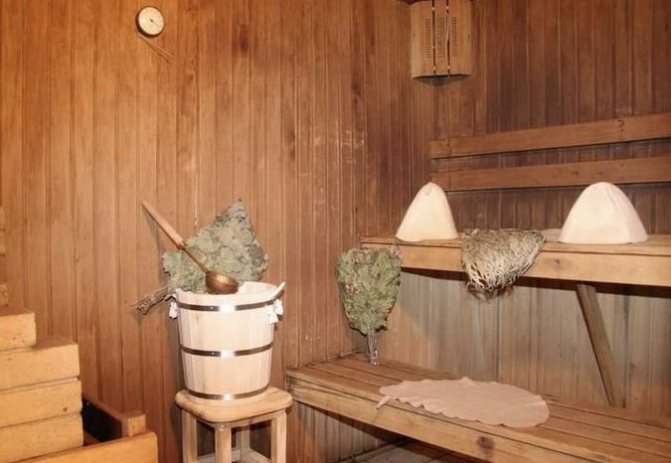
Every owner of a country plot dreams of such a design.
If the very first type of building material is used, it may not have the best effect on the quality of the future structure.
Popular solutions include:
- Today, profiled timber (or rounded logs) is most often used. These materials have a characteristic shape. Profiled timber is characterized by rectilinear shapes, while rounded timber has convex surfaces.
- The finishing of a bathhouse is usually carried out depending on what building material it was built from (in any case, this aspect is important). The surface of the profiled timber does not require additional leveling. However, this cannot be said about the surface of rounded logs.
A Russian bathhouse built according to all the rules is always a source of pride for its owner. After visiting the steam room, your health improves and problems fade into the background - this is a place where you can have a wonderful rest. The “heart” of a sauna building is considered to be a stove, the lining of which is of no small importance.
Stove in the bathhouse
The main room in the bath building is the steam room, where the temperature should be high during the procedures. Steam is no less important. In order for the steam room to function in the desired mode, the stove, the main element of the entire bath, will help to achieve the necessary parameters.
When building or purchasing a heating unit, you must pay attention to the compliance of its functionality with a number of requirements:
- quick heating of the room;
- resistance of the furnace structure to high temperatures;
- the ability to work for a long period;
- beautiful appearance.
Of no small importance for the full functioning of the furnace in the future is the quality of the materials used for its manufacture.
A heating unit installed in a sauna building must not only provide the required temperature conditions, but also have a beautiful appearance. One of the best solutions in this case is deservedly considered to be lining the stove in the bathhouse.
When finishing a stove structure, the following are most often used:
- bricks;
- tiles;
- stone (natural or artificial);
- plaster;
- tiles;
- steel case.
Each of the above materials has its own quality characteristics.
Tiles are a popular type of material used to decorate a sauna stove due to its affordable price and ease of installation.
When lining a stove structure, the following types can be used:
- Clinker tiles. For its production, clay is used, adding energy melters, fireclay and various dyes.
- Majolica tiles. These ceramic products are made from fired clay and covered with glaze. The finished product has a bright and rich color, which is clearly visible in the photo. If desired, ornaments and designs can be applied to such tiles.
- Terracotta tiles. In terms of the components used in the production process, it has much in common with Majolica. But such a lining for a sauna stove is not covered with glaze. The main advantage of “Terracotta” is its high strength. The product is produced in a round shape.
- Marble tiles. A stove with such a finish looks presentable, creating an atmosphere of coziness and comfort in the room. These marble products are characterized by strength and durability. This type of tile has no disadvantages.
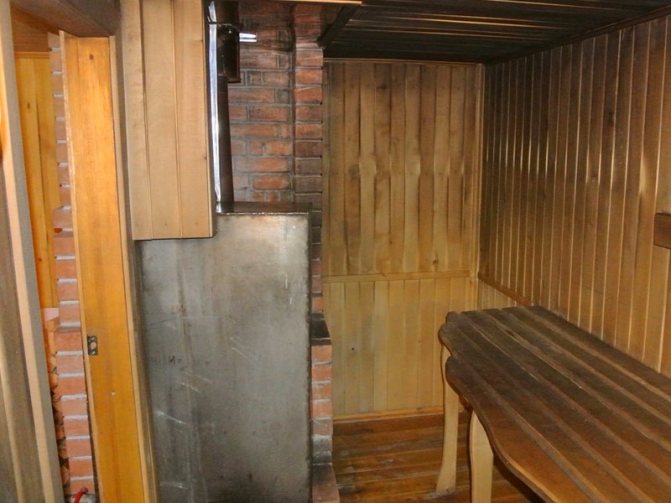
This design option for the heating unit is not only economical, but also easy to implement.
Features of materials
Finishing the stove in a bathhouse is most often done using materials such as natural or artificial stone, tiles or tiles (special tiles). Often, special bricks (red, fireclay or ceramic) are used for such purposes. The simplest and most inexpensive option is clay-based plaster.
You may be interested in: How to make a house extension with your own hands: construction features and design ideas
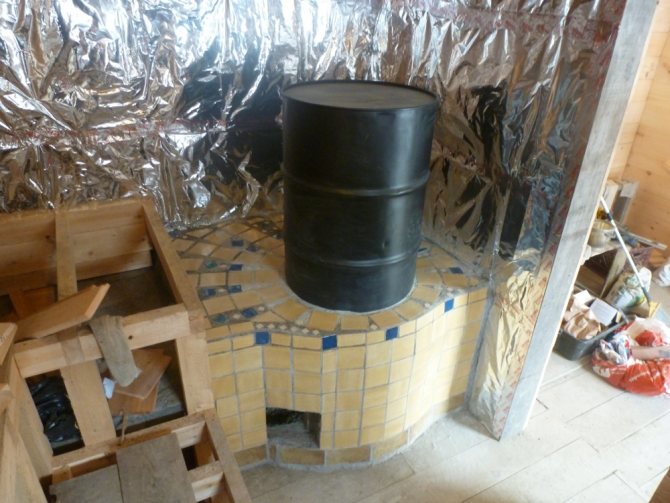
The choice of material depends on the operating characteristics of the furnace. The design also needs to be combined with the existing interior. Facing usually does not require the help of a specialist. Each bathhouse owner can handle this type of work independently.
Experts recommend choosing tiles for cladding. Anyone can lay it on the prepared base themselves. However, other types of materials are often used when lining the furnace. The choice of materials is huge. It is important to take into account the characteristics of each variety. In this case, the work can be done efficiently. Professionals say that even small mistakes made during finishing work are very noticeable. Therefore, you need to perform all actions slowly, carefully and carefully.
Composition and division
Plastering a fireplace is a rather complex and ambiguous process in which it is necessary to apply all available skills and knowledge and not try to do everything faster, not get ahead of yourself and not disrupt the phasing of the work.
Finishing a fireplace with plaster, in turn, implies that when choosing such a material, it is necessary to choose it in strict accordance with certain qualities and characteristics. First of all, heat-resistant plaster for stoves and fireplaces must withstand high heating temperatures and rapid cooling, while such a coating will be not only decorative, but also protective.
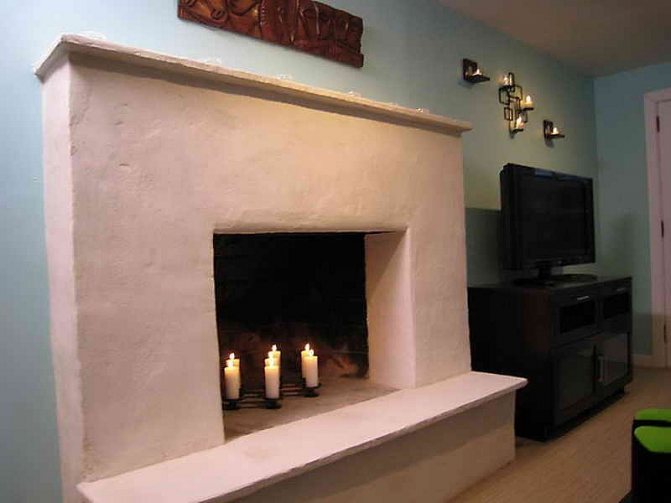
Plaster for stoves can be mixed with your own hands, for this you will need to purchase and prepare the necessary components, it is important that they are of high quality and added strictly in the required proportion. You can also buy a ready-made solution for plastering the surface of stoves, fireplaces, grills, barbecues and other heating units; the most popular are Pechnik and Terracotta solutions.
Plaster, with which the oven will be reliably protected, can perform not only a protective, but also a decorative function, thereby you can choose the most suitable color and structure of such a coating. According to its varieties, decorative plaster can be silicone, mineral, silicate or acrylic; to create a unique and inimitable image, you can buy Venetian plaster, the surface of the fireplace, after application, will be similar to marble with a unique and interesting pattern and color variations.
Plaster for the stove, which can be bought in Moscow and any, even the smallest city, can be Finnish; the surface of the fireplace, covered with such a composition, will be similar to the most expensive natural minerals.
Plastering the stove with your own hands is necessary only after you have purchased a ready-made solution and diluted it in the required proportion with water; alternatively, you can use a special proportion in which you need to prepare and combine certain components. Below you can familiarize yourself with several options and proportions of this composition:
- Mix 1 part finishing clay and mix with 2 parts asbestos and 2 parts sand;
- Take 2 parts sand, 1 part lime, 1 part clay and 1 part asbestos, mix everything;
- 1 part Portland cement, 2 parts sand, 1 part asbestos and 1 part clay - mix everything well until smooth.
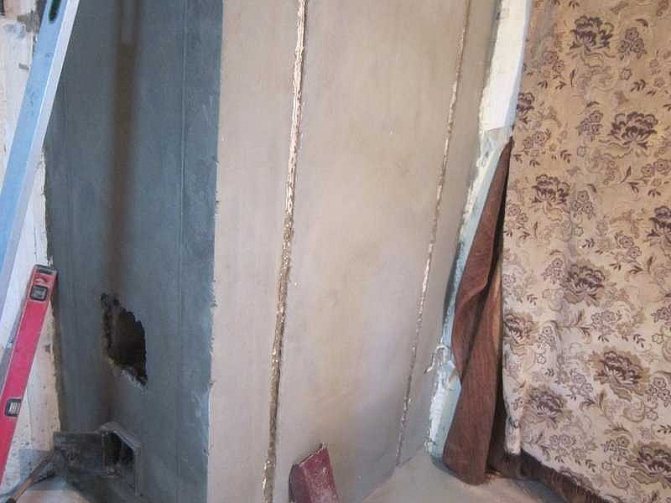
A fireplace, the plaster for which is initially mixed without water, which must be added just before use, will withstand high heating temperatures of up to 900 degrees. Such fire-resistant plaster can be even stronger if you add a little straw to it at the last stage and sift this solution well through a fine sieve, thereby eliminating all pebbles and debris.
The stove, for which the brick is chosen to be of exceptional quality, without cracks, chips, or deformations, in addition, must be stove fireproof, this is especially important if your stove is solid fuel and you need to assemble the firebox and chimney - areas where heating will be maximum.
A stove finished with decorative plaster will not only have good protection, but also an interesting design and decoration that will bring comfort, an indescribable atmosphere and color to your home.
Plaster, the solution of which can either be bought in a specialized store or made with your own hands, must be layered taking into account a number of rules and only in compliance with the necessary sequence, which will ensure such a coating in the future durability and presentability.
The mortar, with which the oven will accumulate thermal energy well, must be fireproof, plastic, thereby it will be able to expand when heated to the required extent and together with the brick and masonry mortar, which will not allow cracks and deformations to form. The composition of such plaster should be as environmentally friendly and natural as possible - this will allow for safe heating of the fireplace stove, in which harmful and hazardous substances will not be released into the air of the room. The clay, with the use of which the stove will warm up well, must, when added to the composition, form a consistency that provides your fireplace stove with good accumulation of heated air, as well as high thermal conductivity, which will ensure maximum and effective overheating of the house.
Brick
To make the right choice, you need to consider the characteristic features of each material. The classic option is to finish the stove in the bathhouse with brick. This is a common type of facing material. The brick prevents the wall from overheating. It can also be laid on the floor. In this case, the space in front of the firebox will also be protected from overheating.
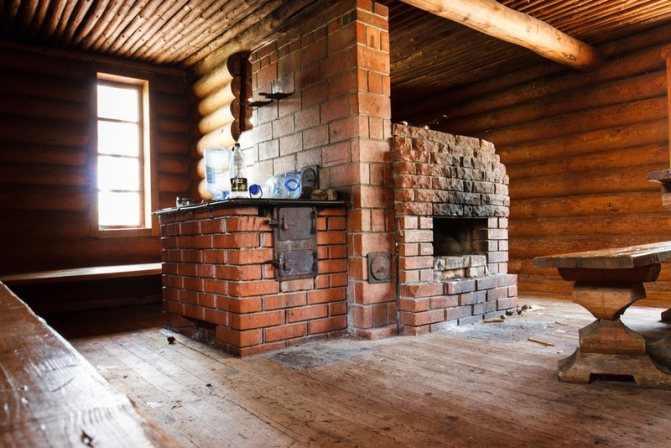
When choosing this material, you need to take into account that there are ordinary and decorative bricks. In the first case, the finishing is made of the same material as the main masonry. However, special decorative varieties of this material look much more impressive. When choosing bricks for finishing, it is necessary to observe the row levels. The seams between them should be thin and uniform.
The portal can be laid with offset rows or evenly. This is only possible if the cladding is done in one layer. During the work process, the master must check the evenness of the masonry using a plumb line and level. If the stove is large, it is better to lay bricks with an offset or parquet pattern. This will make the structure stronger and more stable.
Recommendations from experts
You may be interested in:Soundproofing under laminate: the best methods and materials to reduce noise levels
Finishing the stove in the bathhouse with brick, according to reviews from professional builders, is a good option. It provides good protection of surfaces from overheating. It can be laid directly on wooden floors or walls. In this case, there is no need to install additional fire retardant insulation.
To finish the stove, builders recommend purchasing fire-resistant types of brick. Most often, this material is used to separate structures made of steel or cast iron. Brick promotes uniform heat distribution in the room. It takes a long time to gain temperature. But then it evenly releases heat into the space.
The brick is resistant to moisture. When creating masonry, you need to leave holes. They are needed for free circulation of air flow. The commercially available varieties of refractory bricks allow you to select a material that will match the decorative features of the room.
Types of stove lining
In addition to the fact that the stove is the main heating equipment, it also performs an aesthetic function.
The cladding of the sauna stove is made using practical and durable decorative materials:
- ceramic tiles;
- refractory bricks;
- artificial and natural stone;
- decorative plaster;
- tiles;
- frame made of metal plates.
All materials are distinguished by high performance characteristics and installation features.
The best material for lining a sauna stove is ceramic tiles. It is easy to install, affordable and durable.
The following types of tiles are used for facing work:
- Clinker room. It is made from red clay with the addition of fireclay, melting agent and dye.
- Majolica. Material with a pressed base, covered with a protective glaze layer. This type of tile is distinguished by its rich color scheme, decorative patterns and ornaments.
- Terracotta. A facing material whose performance characteristics are similar to majolica. Important differences are the porous structure and the absence of a protective glaze. Terracotta is characterized by durability, increased strength and resistance to mechanical damage. This type of tile is made in a round shape.
- Marble. This material is distinguished by its increased wear resistance, practicality and ease of installation, and is devoid of almost all disadvantages.
When choosing this type of finishing, stove owners ask themselves the important question of which tiles are best for covering heating equipment. Experts believe that the best option is a material that has a minimum coefficient of thermal expansion and a dense structure - clinker tiles.
Decorating a sauna stove with brick is the simplest and most budget-friendly option for owners who decide to do the cladding themselves.
The material has a number of advantages:
- fast and safe heating;
- accumulation and maintenance of heat for a long time;
- resistance to high moisture;
- low cost and ease of installation.
Work on lining the stove in a bathhouse with bricks consists of arranging a reliable decorative screen around the entire perimeter of the equipment. To increase aesthetics and attractiveness, it is allowed to combine materials of different colors.
To fill the joints, it is recommended to use grout that is resistant to high moisture and temperature changes.
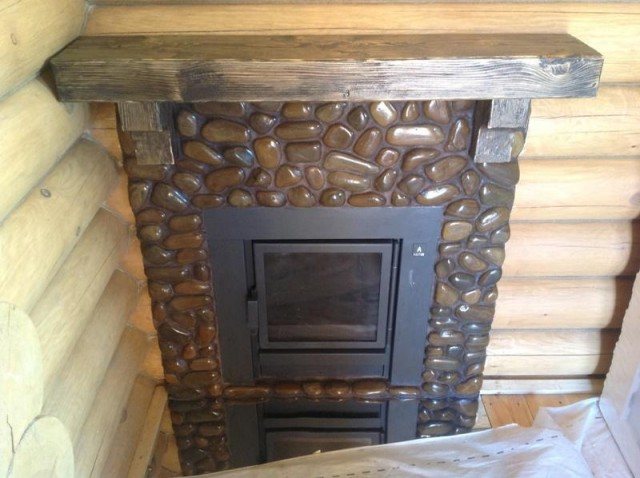
The main advantage of cladding with decorative stone is the creation of a noble and attractive appearance. High strength, durability, environmental friendliness, resistance to high temperatures, a variety of color palettes and textures allow the material to be used for finishing bath rooms.
The following types of stones are used for facing work:
- granite;
- marble;
- coil;
- porcelain stoneware;
- soapstone;
- jade.
Decorative stones can withstand an unlimited amount of heating; they accumulate thermal energy well and maintain a given temperature for a long time. In addition, this material is resistant to acids and alkalis.
In terms of their performance characteristics, artificial elements are not inferior to natural stones. With their help, you can qualitatively line a stove in a steam room or a fireplace in your home.
The technology for laying stones is simple and therefore does not require additional preparation. Non-standard shapes of elements can cause some difficulties during the fitting process, so before installation it is recommended to lay out the material on a flat base. The stones are numbered and fixed on the surface of the furnace using an adhesive composition.
A simple option for lining a Russian stove is plastering the surfaces. Over time, the decorative and protective properties of the plaster composition decrease, which will require frequent renewal of the cladding.
Plastering a stove in a bathhouse is simple; all work is performed in the following order:
- the surface is cleaned of dust, debris and remains of the connecting solution;
- the seams are cleared to a depth of 10 mm;
- Before the cladding begins, the oven warms up;
- a mesh of metal rods is installed on the surface with wire fixation;
- the surface is moistened and a primary layer of plaster mixture is applied;
- After the plaster has hardened, a second layer is applied.
The thickness of each subsequent layer does not exceed 6 mm. The plaster solution is applied using a trowel and leveled over the surface with a spatula. When plastering the surface, it is necessary to avoid the appearance of defects - air bubbles and sagging.
After hardening, the top layer is thoroughly cleaned until a smooth surface is obtained.
The use of tiles is an ancient method of cladding stove equipment for a bath. Tiles are tiles made from pottery plastic clay by firing in a kiln at a temperature of more than 1000 degrees. On the back of the tile there are pumps designed to fix the material on any surface. Tiles are presented in several categories:
- with a smooth surface;
- majolica;
- with glazed surface;
- with a relief surface.
Tiles are distinguished by high performance characteristics - durability, practicality, strength and high heat transfer.
The work of tiling should be entrusted to professionals who will do a good job of installing the material on the surface of the stoves.
A sauna stove can be lined with a metal frame, which is installed on top of the device and covered with protective shields. The steel frame provides reliable protection for the furnace portal and an optimal level of heating of the air in the room.
This type of cladding has the following advantages:
- accumulates released thermal energy;
- quickly heats the air and walls in the room;
- It is distinguished by its affordable price and ease of installation.
A serious drawback of such cladding is the likelihood of burns upon direct contact with the surface. Therefore, experts do not recommend installing metal frames for stoves in bathhouses in order to avoid possible injuries.
A competent choice of decorative material for cladding and adherence to the technological process will ensure the correct operation of the sauna stove and the creation of a comfortable microclimate in the premises.
We invite you to familiarize yourself with a grate for stones in a bathhouse with your own hands
Stone
Finishing the sauna stove with stone would also be appropriate. This material can be natural or artificial. In terms of fire resistance, stone is not inferior to brick. But the appearance of the stove becomes more impressive. The stone is known for its high decorative value.
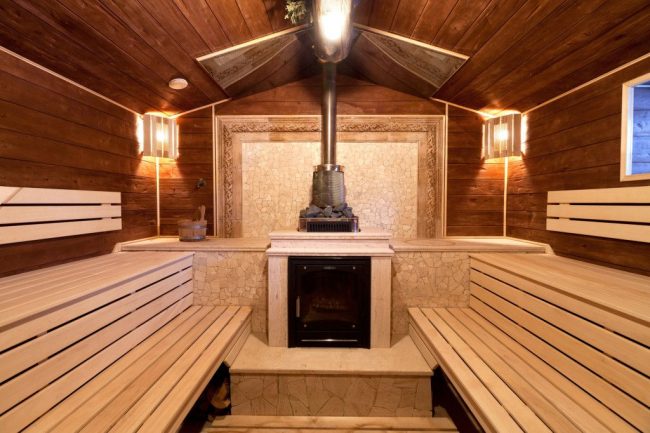
It is worth considering that the finishing is carried out with stone that has undergone special treatment. Raw material is not suitable for these purposes. Natural stone is used to make elements that resemble tiles or blocks in shape. But on the reverse side they should be flat. There are different types of stone. The most popular finishes are granite and marble. However, they may look out of place in a steam room.
The cost of the presented varieties of stone is quite high. Therefore, many bathhouse owners choose other types of materials. It could be sandstone, shale. The second option is often sold chopped in large pieces. For this reason, the cost of the presented material is low.
Tips from builders about stone finishing
Finishing a stove in a bathhouse with decorative stone requires a lot of experience from the master. Laying a portal out of brick is much easier. When dealing with natural stone, you have to deal with the unequal thickness of each decorative element. Their configuration may differ.
Laying portals made of natural stone is often entrusted to professionals. Not every bathhouse owner can handle this work on their own.
Decorative stone that is on sale may be processed or not. The second option is not suitable for a bath. It will quickly become dirty and lose its attractive appearance. This becomes especially noticeable on untreated stones, from which the finishing is made near the floor. Although many owners like the look of untreated stone, it is better to give preference to the processed variety of this material. Their surface must be ground or polished.
Features of the decorative lining of the stove
High-quality finishing of a sauna stove must meet basic operational requirements: withstand high humidity, temperature changes, ensure durability and safety of the surface. The lined stove should quickly heat the bath rooms and create a comfortable microclimate inside.
Lining a stove in a bathhouse has a number of advantages, including the following:
- fast and uniform heating of rooms;
- heat accumulation for a long time;
- minimal risk of getting burned from a heated oven;
- the air does not dry out;
- simplicity and accessibility of maintenance of finished cladding;
- attractive appearance of heating equipment;
- resistance to mechanical damage and deformation.
The dry steam of the sauna heats up to 100-110 degrees Celsius; staying there for a long time is contraindicated, so long breaks of 25-30 minutes are required between entering the steam room. To follow all recommendations for taking a sauna, the following premises are required: a steam room, a shower or a swimming pool and a relaxation room.
A sauna in a city apartment is a miniature steam room, made according to all the canons of a steam room, but heated by electricity. There is no need to install a chimney here; the entire room is occupied only by benches. A shower bar is located in close proximity. The entire complex occupies no more than a couple of meters of space.
A sauna in a separate building made of brick, aerated concrete or logs or built into a private mansion allows you to equip a complex of spacious rooms. The choice of finishing materials is expanding, since for a separate bathhouse, its own calculation of load-bearing structures is made, taking into account the finishing. In the room there is a stove with a chimney running on solid fuel or gas, which is an element of the overall design.
Each of these rooms must have its own temperature and humidity conditions. This should be taken into account when selecting finishes. There are options for uniform design of the entire complex with the same finishing material, for example, tiles. It is better to choose the covering of walls, floors and ceilings in different functional areas according to technical parameters, but in the same style direction.
The internal lining must be resistant to high humidity, be non-flammable and not emit harmful compounds at high temperatures. Materials for a sauna are preferred to be durable, have good performance, easy to clean, and have a high level of hygiene.
When arranging a sauna, compliance with fire safety rules comes first. Hot parts of the stove and chimney should not come into contact with wood trim. Combinations of wood and brick or ceramic tiles are used here. Stainless steel or decorative stone linings have good insulating properties. The insulation should be 50 centimeters above the stove body, and the chimney pipe should be covered with expanded clay in the ceiling.
All sauna rooms are equipped with ventilation systems to provide access to fresh air and remove excess moisture. It is advisable to use dim lighting for better relaxation, but sufficient for good visibility. High temperatures cause a person’s consciousness to slow down and become unfocused, so moving around the room should be comfortable. The active movement area is not cluttered, leaving enough space for bath procedures.
Varnishing or painting surfaces in the steam room is not allowed due to harmful emissions from hot air. Wooden parts are treated with oil or wax and special compounds to prevent rot and mold. Finishing materials are preferable to light colors; this visually increases the space and adds light.
We suggest you familiarize yourself with what to lay stove bricks on
Finishing features
Finishing a sauna stove with decorative or natural stone has many advantages over other materials. In addition to its high ability to accumulate heat, decorativeness and practicality, the presented material has a healing effect on the human body. The structure of stones contains different minerals. When heated, they affect the respiratory tract and other body systems. This statement is true for natural stone.
If the finishing is made of a decorative type of material, it also has a number of advantages. It is relatively inexpensive and yet has an impressive appearance.
Natural and artificial stone are durable finishes. They can extend the life of the furnace. Often used for finishing metal stoves. However, this option is also suitable for brickwork. The stone softens the heat of the stove.
The stones are installed on a special mesh. A sheet of fire-resistant basalt cardboard is installed under it. During the masonry process, a fire-resistant mortar is used. Before installation, natural stones are immersed in water to improve the quality of the finish.
Tile
Finishing the wall of the stove in the bathhouse and firebox is possible using special tiles. It is not inferior in fire resistance to brick and stone. The choice of shapes, shades and patterns of tiles is huge. However, for finishing the stove it is worth choosing special varieties of this material. Porcelain stoneware is well suited for these purposes.
You may be interested in:Connecting a house to gas: rules, procedures and requirements, necessary documents
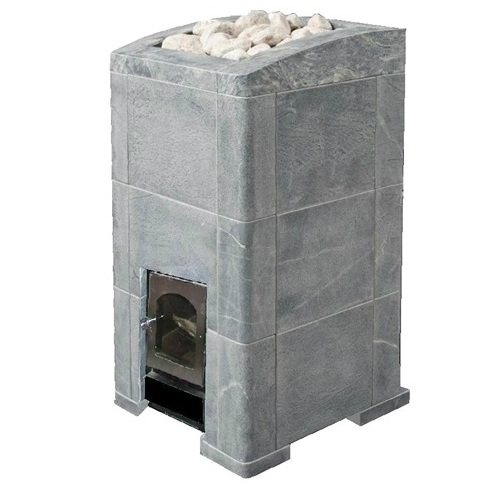
Unlike brick and stone, tiles can have any color and pattern. It is worth considering that installation of tiles on the wall near the stove is carried out only on a pre-installed layer of thermal insulation. If you install the tiles right away, they will not be able to protect the wall from overheating.
Tiles
Finishing the stove in a steam room is often done with a special type of slab. They are called tiles. The technology for producing such material is inexpensive. At the same time, the appearance of the finish is spectacular. This material may have the appearance of a thick tile on the surface. However, this effect can be achieved by using tiles without a pattern.
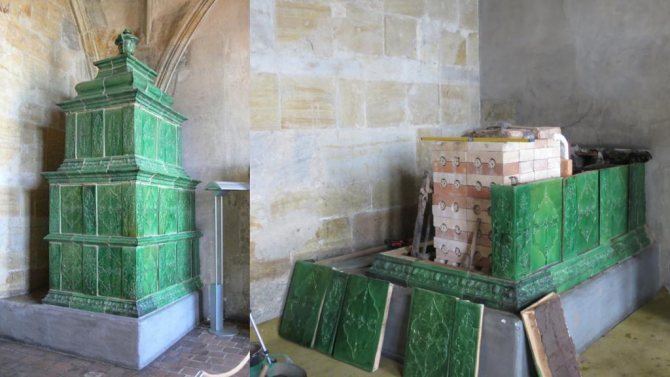
However, much more popular are the materials of this group, which have three-dimensional patterns on the front surface. Such tiles are laid using the same technology as regular tiles. However, the thickness of the finishing layer in this case will be greater. This material is also used to finish part of the floor and wall near the stove.
A special feature of such tiles is the need for correct selection before installation. Each finishing element must be selected according to color. The tiles are compared to each other by shape and shade of glaze. If necessary, uneven edges are sanded before installation. The end result should be a smooth portal. It will become a real masterpiece.
Finishing the bath with stone - natural or decorative
If the stove is made of ordinary stove bricks, not everyone may like its appearance, but if used bricks are also used, then finishing the stove is extremely desirable. There are only two methods - plastering and finishing with tiles or stone (covering with sheet iron, of course, is also a solution, but this is not finishing). But at the same time, the appearance can be very different - from a super-modern to a “terem” version.
One of the most common options for finishing a stove is plaster. Although the method is common, many questions arise: too often the surface cracks, in some cases it even falls off in pieces or completely. In order to avoid such a situation, you need to know some subtleties.
Plastering and finishing with tiles or stone are two ways to tidy up the stove
To clad your log sauna, you can choose a stone - artificial or natural
These finishing materials have only recently become very popular for finishing various rooms. Today, it is often used for lining log baths.
Of course, it is most advisable to use such material to decorate a relaxation room - this should be the case in any bathhouse. The option with stone makes the room very unusual, it takes on a luxurious appearance.
Natural and decorative stone has the following advantages:
- The main advantage of natural or decorative stone in finishing a bath is that each of these materials is moisture resistant. That is, they should only be used in rooms where the air has a high level of humidity. The stone will never lose its shape due to exposure to high temperatures, and it is also not afraid of temperature changes;
- Due to mechanical or physical stress, the stones do not deform. They remain durable and strong, and installation of such materials is easy.
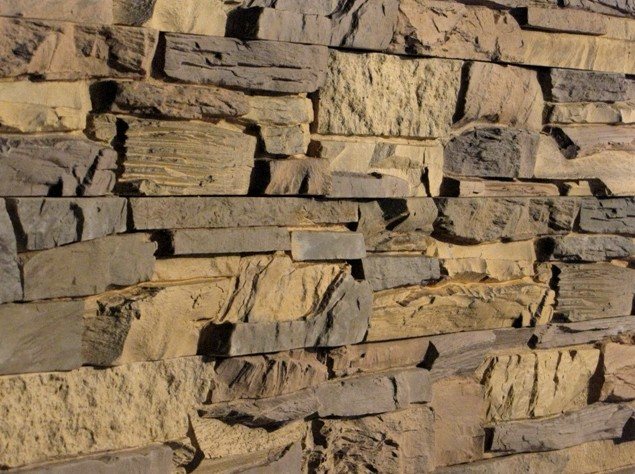
It is easier to work with artificial material, in addition, such stone is cheaper than natural
- To install stone - decorative or natural, it is important to level the surface in advance. If the finishing is done in a wooden structure, plasterboard is often chosen to level the walls.
- Artificial stone is known for its lightness, while natural stone weighs quite a lot. Because of this, when installing natural material, it is important to use a special attribute - reinforcing mesh, which is made from wire. This mesh is usually attached to the wall surface with plaster;
- There is no need for such actions if you are using decorative stone.
To finish a log bath with decorative stone, you will need:
- Building level;
- Concrete or special adhesive solution;
- Putty knife;
- Putty to seal seams (if necessary).
You can lay out stones as you see fit - according to certain sizes or randomly. Here you should focus on what design is made in the room.
When these steps have already been completed, the seams are sealed between the stones. Decorative putty is perfect for masking. However, in certain situations this is not necessary.
Decorative plaster
You can decorate the stove in a bathhouse with your own hands using decorative plaster. This type of material began to be used for such purposes relatively recently. Decorative plaster in this case has certain features. It is not applied to directly finish the brick or metal surface of the stove. This material creates a barrier between the heater and the walls. At the same time, modern varieties of plaster allow you to create interesting design effects.
Plaster is used to finish walls adjacent to the stove. It is worth considering that this material is used if the heater is installed not in a steam room, but, for example, in a relaxation room. The fact is that decorative plaster has a lower moisture resistance. Therefore, it can be used in relatively dry rooms.
Decorative plaster may contain different components. This can be clay and sand, fireclay, gypsum and asbestos, lime. There are also cement-based compositions. The composition may include fiberglass, salt, and chopped straw as additives. Before installation, a fiberglass mesh is installed on the surface. Plaster is applied to it. The heat resistance and thermal conductivity of decorative plaster is high.
Natural stone in sauna decoration
We present to you a new finishing material - natural stone tiles from the Finnish manufacturer Aitokivi.
This is an absolutely universal material - with such tiles you can decorate a wall in a living room, in a bathroom, lay out an apron in the kitchen, decorate a wall in a steam room, or cover the base of a building outside.
Yes, you can still find many other areas of application for natural stone - these are fence posts, a gate arch, a side in a swimming pool or the edge of an artificial pond in the garden.
Since the range of applications is truly limitless, the stone tile manufacturer has written detailed instructions for buyers. By following the installation instructions, you will get a beautiful, durable and long-lasting coating! So, you bought natural stone tiles.
What can we lay it on: 1. On a brick wall; 2. On aerated concrete blocks; 3. On a concrete wall. 4. On a wooden or gypsum fiber wall with additional reinforcement.
The manufacturer advises that for large areas (let's say a wall from floor to ceiling) you should first lay out a brick base.
A wooden or plasterboard surface is absolutely not suitable for placing even a small-sized natural stone finish.
If it is necessary to lay on such a surface, additional reinforcing material should be used, for example, a solid or mineral plate, for example, Knauf Aquapanel Indoor / Outdoor for indoor / outdoor masonry.
1) Before working with tiles, each tile must be cleaned of dust that remains in the grooves and recesses after production. Dust is removed with a stiff brush under water and then dried.
2) The surface of the wall must also be dust-free and thoroughly cleaned from uneven surfaces and mortar deposits. The base primer is used depending on the purpose of the natural stone coating. Primer for exterior use and for interior use are two different primers!
For finishing saunas and baths, it is necessary to use a heat-resistant primer. Don't forget that natural stone in a sauna placed directly next to the stove will get very hot!
The manufacturer recommends using Supi Saunasuoj (Tikkurila) primer for concrete and stone surfaces, which is heat-resistant, in the sauna. The manufacturer recommends using this primer in a place relatively remote from the stove.
A primer, even a heat-resistant one, should not be used in close proximity to the stove. When tiling around the stove, only heat-resistant tile adhesive or stove repair paste should be used. Apply this adhesive mass directly to a dry wall.
3) The manufacturer recommends using a repair mixture of class C2 as adhesive mixtures for natural stone. It is necessary to apply the adhesive mixture both to the wall and to the tile itself.
4) To apply the mixture, you must use a notched trowel with a tooth size of 8-10 mm.
5) The tiles must be cut using either a diamond file or an angle grinder with a diamond disc.
6) You need to start laying from the bottom (from the floor), laying out the first row tightly, without gaps between the tiles. You need to start laying out the top row only after making sure that the bottom row has already “grabbed” firmly. The top row is laid out offset (so-called brickwork). With this installation method, the surface will look as natural as possible.
What the manufacturer Aitokivi pays special attention to:
1) For humid and hot rooms, it is necessary to use only proven products from manufacturers with a wide range of such products. We advise you to pay attention to the installation products of Ardex Oy (X77 and X77S). Since these adhesives are produced in the form of dry mixtures, you must carefully follow the instructions for preparing the solution and take into account the thickening time of the composition!
2) If the finishing stone is used in the finishing of wet rooms (showers, swimming pools, as well as for external cladding and finishing of small gardens), it is necessary to process the stone covering, especially carefully going through the masonry seams. This will prevent the growth of fungal cultures, as well as moss and lichen, which can destroy the finish. The manufacturer recommends its own protective product from the Aitokivi brand in the form of a plastic bottle with a spray bottle.
Additional treatment with a protective compound will preserve the original color of the natural stone tiles.
For external corners, the manufacturer produces natural stone tiles for each type.
Steel case
The finishing around the stove in the bathhouse can be done using another technology. Steel can be used for this. This is a fire resistant material. There is no point in finishing the walls around the stove using this material.
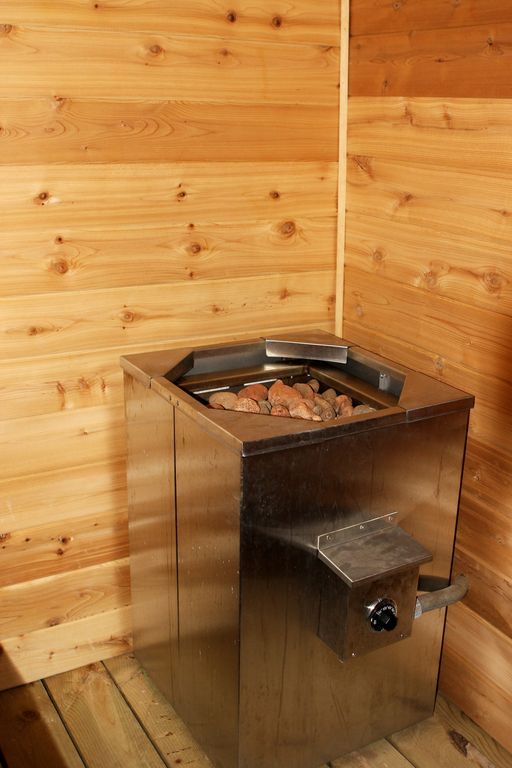
Steel conducts heat quickly. It does not protect surfaces from overheating. Therefore, fire-resistant trim is installed first. It will perform a protective function. Steel plays the role of a decorative element.
When choosing a steel case, you should give preference to metal that has been processed in a special way. In this case, the material will not be subject to corrosion.
Coloring
Another possible option for finishing a sauna stove is painting. This is a simple, relatively inexpensive way to create a decorative layer. Paint can be applied to almost any surface. However, preference should be given to its heat-resistant varieties. Regular paint will not work for these purposes.
Moisture-resistant silicone-based compounds are suitable for such purposes. Before applying paint, the surface is cleaned with sandpaper and degreased.
Having considered the options for finishing the stove in the bathhouse, you can choose the best option in accordance with your taste preferences and the characteristics of the interior of the room.
Source
